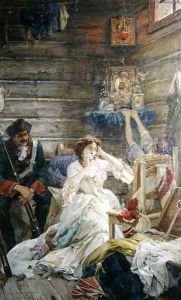Pavel Alexandrovich Svedomsky Paintings
Pavel Alexandrovich Svedomsky was a Russian painter born on July 13, 1849, in St. Petersburg. He was part of a generation of Russian artists who received a significant portion of their education abroad and were influenced by the European academic art of the time. Svedomsky’s artistic journey began at the Imperial Academy of Arts in St. Petersburg, where he studied from 1869 to 1871. He continued his education in Rome, which was a popular destination for artists wishing to absorb the traditions of classical and Renaissance art.
While in Italy, Svedomsky worked and developed his skills alongside his brother, Alexander Svedomsky, who was also a painter. The two brothers often collaborated on works, and this partnership further honed Pavel's style, which was characterized by a blend of academic classicism and romanticism. His subjects frequently included historical scenes, religious themes, and mythology, rendered with a dramatic flair and meticulous attention to detail.
Svedomsky's work was well-received in his time, and he participated in a number of important projects. One of his notable contributions was to the decoration of the Cathedral of Christ the Saviour in Moscow, where he worked on the frescoes alongside other prominent artists of the era. His paintings were also exhibited in various prestigious venues, including the Paris Salon, and they garnered positive attention for their technical skill and evocative storytelling.
Despite his success and recognition, Svedomsky's life was relatively short. He died on May 2, 1904, in Penza, which is situated southeast of Moscow, at the age of 54. Although not as widely known today as some of his contemporaries, his works are preserved in several Russian museums, including the Tretyakov Gallery, and they continue to be appreciated by connoisseurs of 19th-century Russian art. Svedomsky's legacy is that of a skilled painter who captured the spirit of his time through a blend of traditional academic painting and the rich narrative of historical and mythological subjects.
